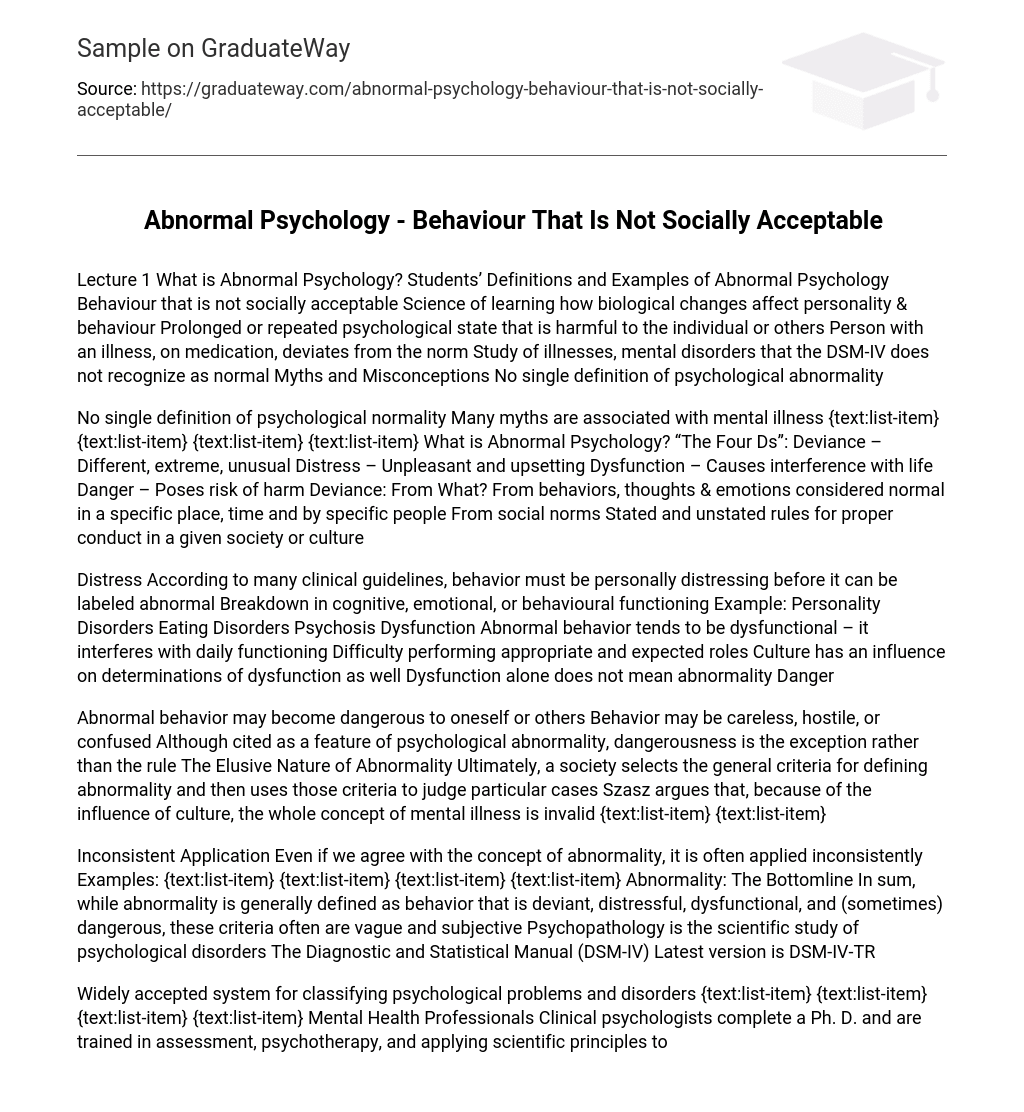Lecture 1 What is Abnormal Psychology? Students’ Definitions and Examples of Abnormal Psychology Behaviour that is not socially acceptable Science of learning how biological changes affect personality & behaviour Prolonged or repeated psychological state that is harmful to the individual or others Person with an illness, on medication, deviates from the norm Study of illnesses, mental disorders that the DSM-IV does not recognize as normal Myths and Misconceptions No single definition of psychological abnormality
No single definition of psychological normality Many myths are associated with mental illness {text:list-item} {text:list-item} {text:list-item} {text:list-item} What is Abnormal Psychology? “The Four Ds”: Deviance – Different, extreme, unusual Distress – Unpleasant and upsetting Dysfunction – Causes interference with life Danger – Poses risk of harm Deviance: From What? From behaviors, thoughts & emotions considered normal in a specific place, time and by specific people From social norms Stated and unstated rules for proper conduct in a given society or culture
Distress According to many clinical guidelines, behavior must be personally distressing before it can be labeled abnormal Breakdown in cognitive, emotional, or behavioural functioning Example: Personality Disorders Eating Disorders Psychosis Dysfunction Abnormal behavior tends to be dysfunctional – it interferes with daily functioning Difficulty performing appropriate and expected roles Culture has an influence on determinations of dysfunction as well Dysfunction alone does not mean abnormality Danger
Abnormal behavior may become dangerous to oneself or others Behavior may be careless, hostile, or confused Although cited as a feature of psychological abnormality, dangerousness is the exception rather than the rule The Elusive Nature of Abnormality Ultimately, a society selects the general criteria for defining abnormality and then uses those criteria to judge particular cases Szasz argues that, because of the influence of culture, the whole concept of mental illness is invalid {text:list-item} {text:list-item}
Inconsistent Application Even if we agree with the concept of abnormality, it is often applied inconsistently Examples: {text:list-item} {text:list-item} {text:list-item} {text:list-item} Abnormality: The Bottomline In sum, while abnormality is generally defined as behavior that is deviant, distressful, dysfunctional, and (sometimes) dangerous, these criteria often are vague and subjective Psychopathology is the scientific study of psychological disorders The Diagnostic and Statistical Manual (DSM-IV) Latest version is DSM-IV-TR
Widely accepted system for classifying psychological problems and disorders {text:list-item} {text:list-item} {text:list-item} {text:list-item} Mental Health Professionals Clinical psychologists complete a Ph. D. and are trained in assessment, psychotherapy, and applying scientific principles to the study of abnormal psychology {text:list-item} Social workers generally hold a M. S. W. and are committed to action that may be socially based or individually based Epidemiology of Abnormality {text:list-item} {text:list-item} Epidemiology of Abnormality
Comorbidity—the presence of more than one condition at one time Gender differences are found in many but not all mental disorders Causation, Treatment, and Outcome in Psychopathology Study of etiology {text:list-item} How can we best improve the lives of people suffering from psychopathology? {text:list-item} {text:list-item} How do we know that we have alleviated psychological suffering? {text:list-item} {text:list-item} Historical Conceptions of Abnormal Behaviour Three dominant traditions include: Supernatural Biological Psychological Supernatural Tradition: Deviant Behaviour: {text:list-item} {text:list-item} text:list-item} Few believed that abnormality was an illness on par with physical disease Throughout the 18th century: Shrines devoted to loving care of the mentally ill were established {text:list-item} This time also saw a rise of asylums {text:list-item} The intention was good care, but with overcrowding came “warehousing” of patients As 1800 approached, asylums were reformed into places of care and rise of moral therapy {text:list-item} Advocates of moral treatment: {text:list-item} {text:list-item} {text:list-item} {text:list-item} {text:list-item} {text:list-item} The somatogenic perspective: text:list-item} The psychogenic perspective: {text:list-item} Mental Illness = Physical Illness Two factors responsible for reemergence: {text:list-item} {text:list-item} This approach, while creating optimism, lead to few positive results until the 1950s Consequences of the Biological Tradition The 1930’s: Biological treatments were standard practice {text:list-item} The 1950’s: People with severe disturbances were starting to be treated with psychotropic medications {text:list-item} {text:list-item} {text:list-item}
These discoveries led to deinstitutionalization and a rise in outpatient care The rise in popularity of this psychogenic model was based on work with hypnotism by: {text:list-item} {text:list-item} Unconscious processes cause abnormality Freud & Psychoanalysis {text:list-item} {text:list-item} {text:list-item} {draw:frame} Development occurs through the psychosexual stages (oral, anal, phallic, latency, & genital) Unearth the hidden intrapsychic conflicts (“the real problems”) Therapy is often long term
Techniques include free association and dream analysis Little evidence for efficacy Humanistic Theory Major Theme {text:list-item} {text:list-item} Treatment {text:list-item} {text:list-item} No strong evidence that humanistic therapies work *The Influence of Learning Theory on Behavioural* Therapy {text:list-item} {text:list-item} Operant conditioning (Thorndike, Skinner) {text:list-item} {text:list-item} *From Behaviourism* to Behaviour Therapy Contributed to a reactionary movement against psychoanalysis and non-scientific approaches Early Pioneers {text:list-item} {text:list-item} {text:list-item}
Behaviour therapy tends to be time-limited and direct Strong evidence supporting the efficacy of behaviour therapy in treatment of certain disorders (e. g. phobias) *What Are Today’s* Leading Theories? One important development in the field of abnormal psychology is the growth of theoretical perspectives (orientations), including: Psychoanalytic (e. g. , “talk therapy”) Biological (e. g. , medication; chemical imbalance) Behavioral (e. g. , behavioural activation) Cognitive (e. g. , thoughts influence feelings) Humanistic-existential (e. g. , self-actualization)





